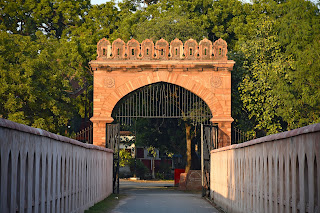Northern Delhi
On Tuesday, I had an appointment at Ashoka University, a relatively new institution whose vision has attracted major investors and academic heavyweights. Modelled along the lines of American liberal arts colleges, it dubs itself the Harvard of Haryana, the Yale on the Yamuna, and several other slogans I cannot remember. I was surprised to find the campus quite small and cozy, housing only around 3,000 students. Nevertheless, it has already grown significantly since the time my friend Sparsh studied there, and is now expanding by another whole campus.
Because
Ashoka lies over an hour’s journey north of Delhi, I planned my entire day
around the trip. In the morning, I used the good weather to make a quick stop by
Jama Masjid before returning to my hotel (I found it necessary to go back in
case my Uber driver tried to call me and I needed someone to answer the phone).
Built by Shah Jahan, Jama Masjid was the Mughals’ imperial mosque, and it
remains a prayer site to this day. Upon entry, visitors are even asked to take
off their shoes, which the custodian keeps safe for a fee. In my case, the
custodian simply took the 500 note I had given him for the 300-rupee camera
fee. I politely declined to give him any more money when he asked for it upon
returning my shoes.
On that
note, I have gotten quite good at gauging fair prices for automobile rickshaw
rides, and I hold my own when someone offers me a blatantly overshot price.
However, when I do not have any small denominations in my wallet, all my rides invariably
become a flat 500 rupees, as every driver denies having any change. Of course, I
would feel exceedingly silly trying to debate them on that point, seeing as the
difference approximates to around two or three euros (or rather one or two, as
I like to leave a tip).
I returned
from Ashoka with just enough time to visit the Red Fort before the sun set. My
friend Smayan had advised me to take the school shuttle back to Delhi, and I rode
a rickety rickshaw from its terminus at a northern metro station. I usually
don’t feel afraid when taking autorickshaws, as traffic tends to keep speeds
unthreatening. The ring road that leads to the Red Fort, however, was quite a
different matter, and I grew genuinely concerned as cars and trucks passed by
us at a breakneck pace.
When
approached from the north, the Red Fort emerges as a fantastical apparition
dwarfing every building in sight. Commissioned by Shah Jahan (and designed by
Ustad Ahmad Lahori of Taj Mahal fame), it attracts great crowds of tourists from
India and the wider world. Tourists from the latter, I should note, become part
of the attraction to many of those from of the former, and I engaged in an
occasional broken conversation before being released from my awkward misery
with a quick selfie. Behind the iconic red wall of the fort, I found a number
of white buildings including a mosque, a residence, and a palace. Most of the
space, however, is occupied by a large park, where the citizens of Delhi tend
to stroll around and sit down to picnic.



































Comments
Post a Comment